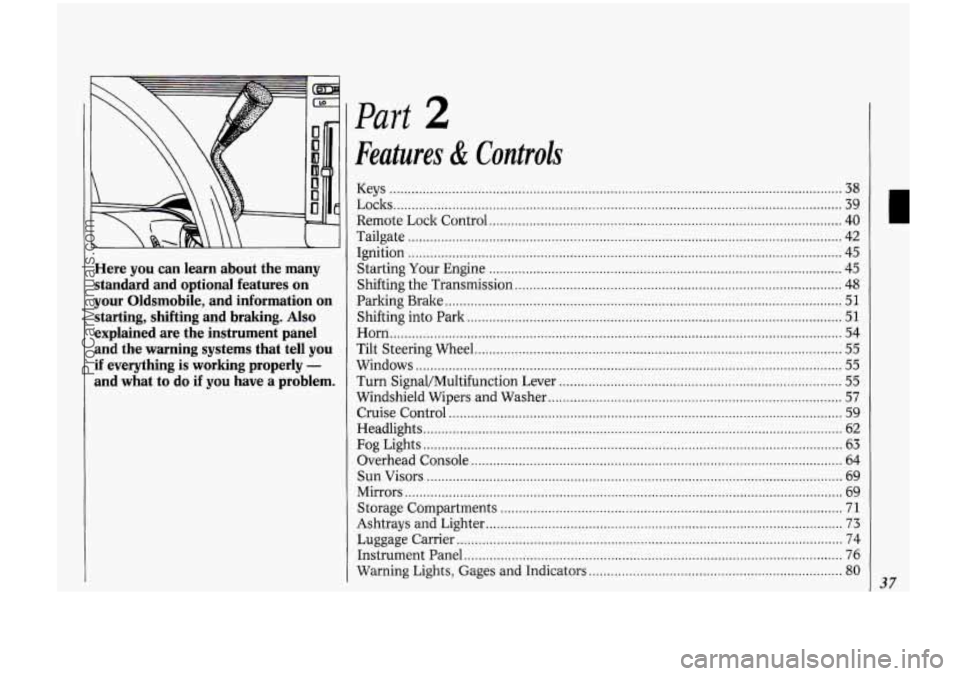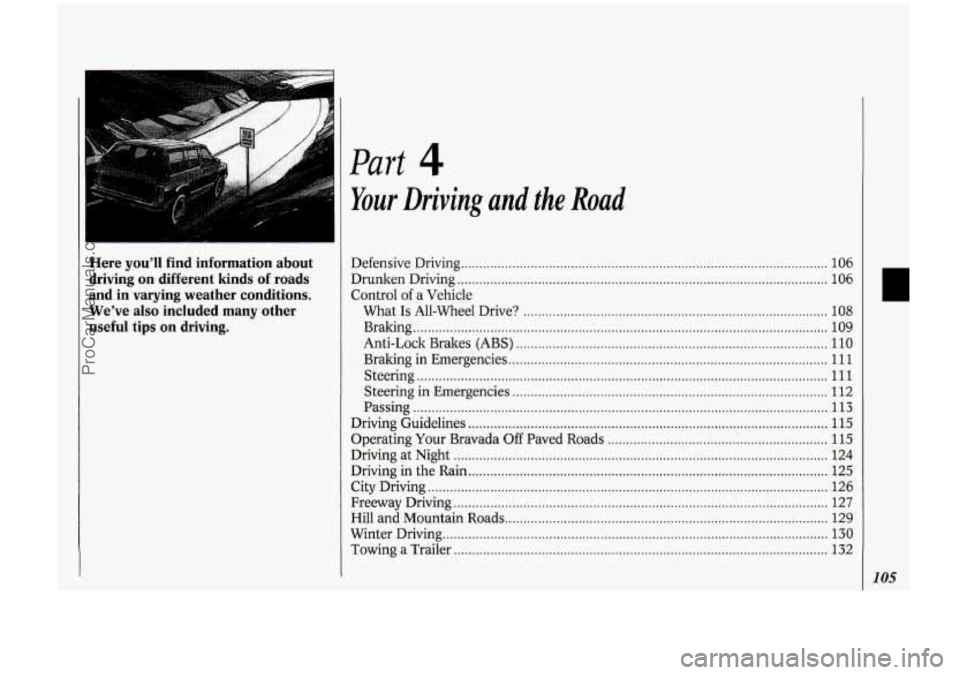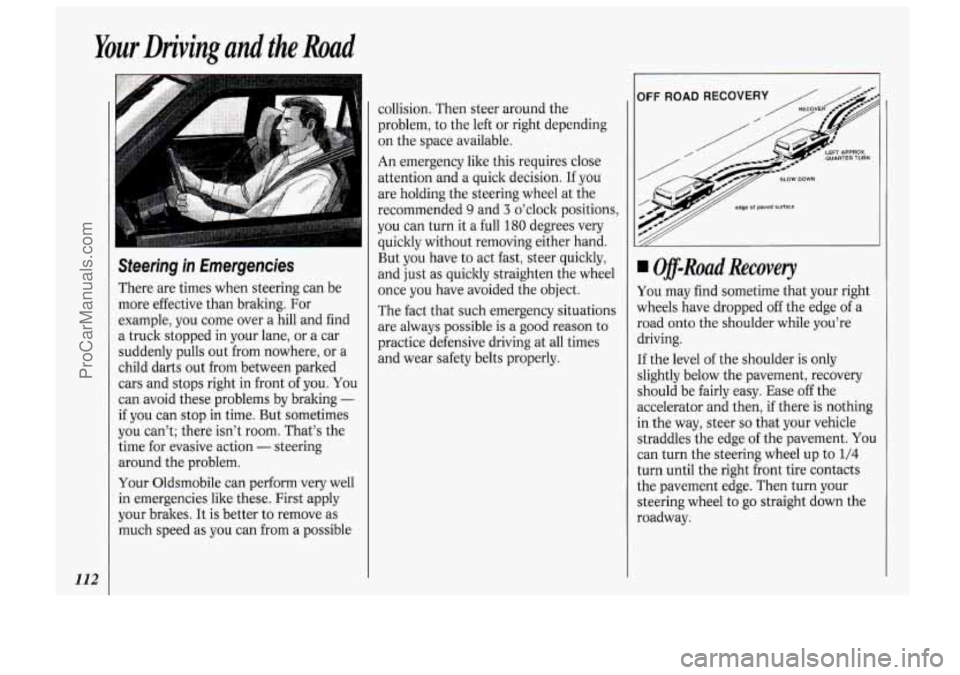steering OLDSMOBILE BRAVADA 1994 Owners Manual
[x] Cancel search | Manufacturer: OLDSMOBILE, Model Year: 1994, Model line: BRAVADA, Model: OLDSMOBILE BRAVADA 1994Pages: 248, PDF Size: 14.54 MB
Page 43 of 248

Here you can learn about the many standard and optional features on
your Oldsmobile. and information on
starting. shifting and braking
. Also
explained are the instrument panel
and the warning systems that tell you
if everything is working properly -
and what to do if you have a problem .
Part 2
Features & Controls
Keys ........................................................................\
.......................................... .. ....... 38
Locks ........................................................................\
.................................................. 39
Remote Lock Control
........................................................................\
........................ 40
Tailgate ........................................................................\
.............................................. 42
Ignition ........................................................................\
.............................................. 45
Starting Your Engine ........................................................................\
........................ 45
Shifting the Transmission ........................................................................\
................. 48
Parking Brake ........................................................................\
.................................... 51
Shifting into Park ........................................................................\
.............................. 51
Horn ........................................................................\
................................................... 54
Tilt Steering Wheel ........................................................................\
............................ 55
Windows ........................................................................\
............................................ 55
Turn Signal/Multifunction Lever ........................................................................\
..... 55
Windshield Wipers and Washer ........................................................................\
........ 57
Cruise Control ........................................................................\
................................... 59
Headlights
........................................................................\
.......................................... 62
Fog Lights ........................................................................\
.......................................... 63
Overhead Console
........................................................................\
............................. 64
Sun Visors
........................................................................\
......................................... 69
Mirrors
........................................................................\
............................................... 69
Storage Compartments
........................................................................\
..................... 71
Ashtrays and Lighter
........................................................................\
......................... 73
Luggage Carrier ........................................................................\
................................. 74
Warning Lights, Gages and Indicators
..................................................................... 80
Instrument Panel ........................................................................\
............................... 76
37
ProCarManuals.com
Page 48 of 248

Features & Controls
42
2. Lift the front cover off, bottom half
3. Remove and replace the batteries
4. Reassemble the transmitter.
5. Check the transmitter operation.
first.
(2016).
Theft
Vehicle
theft is big business, especially
in some cities. Although your
I Oldsmobile has a number of theft
deterrent features, we know that
nothing we put on it can make it
impossible to steal. However, there are
ways you can help.
Key in the Ignition
If you walk away from your vehicle with
the keys inside, it’s an easy target for
joy riders
or professional thieves - so
don’t do it.
When
you park your Oldsmobile and
open the driver’s door, you’ll hear a
tone reminding you to remove your key
from the ignition and take it with you.
Always do this. Your steering wheel
will be locked, and
so will your ignition
and transmission. And remember to
lock the doors.
Parking at Night
Park in a lighted spot, close all windows
and lock your vehicle. Remember to
keep your valuables out of sight. Put
them in a storage area, or take them
with you.
Parking Lots
If you park in a lot where someone will
be watching your vehicle, it’s best to
lock it up and take your keys. But what
if you have to leave your ignition key?
What
if you have to leave something
valuable
in your vehicle?
Put your valuables in a storage area,
like your glove box.
Lock the glove box.
Lock all the doors except the driver’s.
Then take the door key with you.
Tailgate Lock
From the outside, use the round key to
open the tailgate. With the key in the
lock, turn the lock handle to the left to
unlock the window.
Raise the window, then turn the lock
handle to the right to unlock the
tailgate.
ProCarManuals.com
Page 51 of 248

U
Ignition Switch
With the ignition key in the ignition
switch, you can turn the switch to five
positions:
Accessory: An “on7’ position in which
you can operate your electrical power
xcessories. Press in the ignition switch
2s you turn the top of it toward you.
Lock: The only position in which you
:an remove the key. This locks your
steering wheel, ignition and
transmission.
Off: Unlocks the steering wheel,
ignition, and transmission, but does not
send electrical power to any accessories.
Use this position if your vehicle must be
pushed or towed, but never try to push-
start your vehicle. A warning chime will
sound if you open the driver’s door
when the ignition is off and the key is in
the ignition.
Run: An “on” position to which the
switch returns after you start your
engine and release the switch. The
switch stays in the
Run position when
the engine is running. But even when
the engine
is not running, you can use
Run to operate your electrical power
accessories, and to display some
instrument panel warning lights.
Start: Starts the engine. When the
engine starts, release the key. The
ignition switch will return to
Run for
normal driving.
Note that even if the engine is not
running, the positions
Accessory and
Run are “on” positions that allow you
to operate your electrical accessories,
such as the radio.
NOTICE:
If your key seems stuck in Lock
and you can’t turn it, be sure it is
all the way in.
If it is, then turn the
steering wheel left and right while
you turn the key hard. But turn the
key only with your hand. Using a
tool to force it could break the key
or the ignition switch. If none of
this works, then your vehicle needs
service.
Starting Your Engine
Move your shift lever to P (Park) or
N (Neutral). Your engine won’t start in
any other position
- that’s a safety
feature. To restart when you’re already
moving, use
N (Neutral) only.
NOTICE:
Don’t try to shift to P (Park) if your
Oldsmobile is moving. If you do,
you could damage the transmission.
Shift to
P (Park) only when your
vehicle is stopped.
45
ProCarManuals.com
Page 60 of 248

Features & Controk
54
Running Your Engine While You’re Parked
It’s better not to park with the engine
running. But if you ever have to, here
are some things to know.
Follow the proper steps to be sure your
vehicle won’t move.
See Shifting Into P
(Park) in the Index.
If you are parking on a hill and pulling
a trailer, also see
Towing a Trailer in
the
Index.
Horn
You can sound the horn by pressing the
horn symbol on your steering wheel.
ProCarManuals.com
Page 61 of 248

Tilt Steering Wheel
A tilt steering wheel allows you to
adjust the steering wheel before you
drive. You can also raise it to the
highest level to give your legs more
room when you exit and enter the
vehicle.
To tilt the wheel, hold the steering
wheel and pull the lever. Move the
steering wheel
to a comfortable level,
then release the lever to lock the wheel
in place.
Power Windows
Switches on the driver's door control
each of the windows when the ignition
is on. In addition, each passenger door
has a control switch for its own
.- window.
'I- I
4 Turn SignullMukifinction
Lever
The lever on the left side of the steering
column includes your:
Turn Signal and Lane Change
Cruise Control
Headlight High-Low Beam
Windshield Wipers
Windshield Washer
The High-Low Beam feature is
discussed under
Headlights. See the
Index under Headlights.
Indicator
3
55
ProCarManuals.com
Page 83 of 248

The Instrument Panel-Your
Information System
Your instrument panel is designed to let
you know at a glance how your vehicle
is running. You’ll know how fast you’re
going, how much fuel you’re using, and
many other things you’ll need to drive
safely and economically.
The main components
of your
instrument panel are:
1. Side Vents
2. Side Window Defogger
3. Rear Window Wipermasher
4. Rear Window Defogger
5. Light Controls
6. Tilt Steering Wheel Lever
7. Instrument Cluster
8. Gearshift Lever
9. Climate Controls
IO. Lighter
11. Center Vents
12. Glove Box
13. Side Window Defogger
14. Side Vents
15. Audio System
16. Ashtray
17. Tailgate Window Release
18. Power Remote Control Mirrors
19. Ignition Switch
20. Hazard Warning Flashers Switch
21. Horn
22. Fuse Panel (under instrument
panel)
23. Hood Release
24. Turn Signal/Multifunction Lever
25. Parking Brake Release
77
ProCarManuals.com
Page 111 of 248

Here you’ll find information about
driving on different kinds
of roads
and in varying weather conditions
.
We’ve also included many other
useful tips
on driving .
Part 4
Your Driving and the Road
Defensive Driving .. ............................................... ................................................... 106 . ..
Drunken Driving ........................................................................\
............................. 106
Control of a Vehicle
What
Is All-Wheel Drive? ........................................................................\
........... 108
Braking ........................................................................\
......................................... 109
Anti-Lock Brakes (ABS)
........................................................................\
............. 110
Braking in Emergencies
........................................................................\
............... 111
Steering ........................................................................\
........................................ 111
Steering in Emergencies ........................................................................\
.............. 112
Passing ........................................................................\
......................................... 113
Driving Guidelines ........................................................................\
.......................... 115
Operating Your Bravada
Off Paved Roads ............................................................ 115
Driving at Night
........................................................................\
.............................. 124
Driving
in the Rain ........................................................................\
.......................... 125
City Driving
........................................................................\
..................................... 126
Freeway Driving ........................................................................\
.............................. 127
Hill and Mountain Roads ........................................................................\
................ 129
Winter Driving
........................................................................\
................................. 130
Towing a Trailer ........................................................................\
.............................. 132
..
105
ProCarManuals.com
Page 114 of 248

Your Driving and the Road
108
“I’ll be careful” isn’t the right answer.
What
if there’s an emergency, a need to
take sudden action, as when a child
darts into the street? A person with a
higher BAC might not be able to react
quickly enough to avoid the collision.
There’s something else about drinking
and driving that many people don’t
know. Medical research shows that
alcohol in a person’s system can make
crash injuries worse. That’s especially
true for brain, spinal cord and heart
injuries. That means that
if anyone who
has been drinking
- driver or
passenger
- is in a crash, the chance of
being killed or permanently disabled is
higher than
if that person had not been
drinking. And we’ve already seen that
the chance
of a crash itself is higher for
drinking drivers. You
have three systems that
make your
vehicle go where you want it
to go.
They are the brakes, the steering and
the accelerator. All three systems have
to do their work at the places where the
tires meet the road.
Sometimes, as when you’re driving on
snow or ice, it’s easy to ask more
of
those control systems than the tires and
road can provide. That means you can
lose control of your vehicle,
Wt Is All-Wheel Drive?
All the Wheels, All the Time
Bravada has a unique system called all-
wheel drive
(AWD) . Simply stated,
AWD supplies power from the engine to
all four wheels, all the time. It works in
ProCarManuals.com
Page 117 of 248

Braking in Emergencies
Use your anti-lock braking system when
you need to. With anti-lock, you can
steer and brake at the same time. In
many emergencies, steering
can help you
more than even the very best braking.
I Steering
Power Steering
If you lose power steering assist
because the engine stops or the system
is not functioning, you can steer but it
will take much more effort.
Steering Tips
Driving on Curves
It’s important to take curves at a
reasonable speed.
A lot of the “driver lost control”
accidents mentioned on the news
happen on curves. Here’s why:
Experienced driver or beginner, each of
us is subject to the same laws of physics
when driving on curves. The traction of
the tires against the road surface makes
it possible for the vehicle to change its
path when you turn the front wheels. If
there’s no traction, inertia will keep the vehicle going in
the same direction. If
you’ve ever tried to steer a vehicle on
wet ice, you’ll understand this.
The traction you can get in
a curve
depends on the condition of your tires
and the road surface, the angle at which
the curve is banked, and your speed.
While you’re in a curve, speed is the one
factor you can control.
Suppose you’re steering through
a
sharp curve. Then you suddenly
accelerate. Both control systems
-
steering and acceleration - have to do
their work where the tires meet the
road. Adding the sudden acceleration
can demand too much of those places.
You can lose control.
Suppose you’re steering through
a
sharp curve. Then you suddenly
accelerate. Both control systems
-
steering and acceleration - have to do
their work where the tires meet the
road. Unless you have traction control
and the system is on, adding the sudden
acceleration can demand too much of
those places.
You can lose control. What
should you do if this ever
happens? Ease up on the accelerator
pedal, steer the vehicle the way you
want it to go, and slow down.
Speed limit signs near curves warn that
you should adjust your speed. Of
course, the posted speeds are based on
good weather and road conditions.
Under less favorable conditions you’ll
want to go slower.
If you need to reduce your speed as you
approach a curve, do it before you enter
the curve, while your front wheels are
straight ahead.
Try to adjust your speed
so you can
“drive” through the curve. Maintain a
reasonable, steady speed. Wait to
accelerate until you are out of the curve,
and then accelerate gently into the
straightaway.
111
ProCarManuals.com
Page 118 of 248

Your Driving and the Road
112
Steering in Emergencies
There are times when steering can be
more effective than braking. For
example, you come over a hill and find
a truck stopped in your lane,
or a car
suddenly pulls out from nowhere, or a
child darts out from between parked
cars and stops right in front of you.
You
can avoid these problems by braking -
if you can stop in time. But sometimes
you can’t; there isn’t room. That’s the
time for evasive action
- steering
around the problem.
Your Oldsmobile can perform very well
in emergemies like these. First apply
your brakes. It is better to remove as
much speed as
you can from a possible collision. Then
xeer around the
problem, to the left or right depending
on the space available.
An emergency like this requires close
attention and
a quick decision. If you
are holding the steering wheel at the
recommended
9 and 3 o’clock positions,
you can turn it a
full 180 degrees very
quickly without removing either hand.
But you have to act fast, steer quickly,
and just as quickly straighten the wheel
once
you have avoided the object.
The fact that such emergency situations
are always possible is
a good reason to
practice defensive driving at all times
and wear safety belts properly.
, IOFF ROAD RECOVERY /
Off-Road Recovery
You may find sometime that your right
wheels have dropped off the edge of a
road onto the shoulder while you’re
driving.
If the level of the shoulder is only
slightly below the pavement, recovery
should be fairly easy. Ease
off the
accelerator and then, if there is nothing
in the way, steer
so that your vehicle
straddles the edge of the pavement.
You
can turn the steering wheel up to 1/4
turn until the right front tire contacts
the pavement edge. Then turn your
steering wheel to
go straight down the
roadway.
ProCarManuals.com